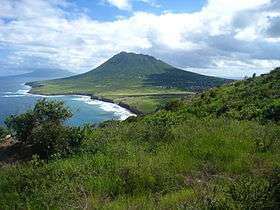The Quill (volcano)
| The Quill | |
|---|---|
 Looking southeast across Statia toward the Quill | |
| Highest point | |
| Elevation | 601 m (1,972 ft) |
| Prominence | 601 m (1,972 ft) |
| Coordinates | 17°28′40″N 62°57′35″W / 17.47778°N 62.95972°WCoordinates: 17°28′40″N 62°57′35″W / 17.47778°N 62.95972°W |
| Geography | |
 The Quill | |
| Geology | |
| Mountain type | Stratovolcano |
| Last eruption | 250 CE ± 150 years |
The Quill /ˈkwɪl/ is a dormant stratovolcano located on the island of Sint Eustatius in the Caribbean Netherlands. The summit elevation is 601 metres (1,972 ft) above sea-level.[1] It is also the second highest mountain in the Netherlands.
The name 'Quill' originates from the Dutch term kuil ([ˈkœyl]), meaning 'pit' or 'hole', which was used originally with reference to the volcanic crater. The Quill was designated as a national park by the government of the Netherlands Antilles in 1998. It is administered by the Sint Eustatius National Parks Foundation, STENAPA, which maintains a number of trails for hikers.
The Quill formed between 22,000 and 32,000 years before present to the southeast of Sint Eustatius (Statia) in the West Indies. Pyroclastic flows during the initial eruption joined the Quill with what is now the rest of Sint Eustatius.[1] The Quill has been active since its birth; the last known eruption, as determined by carbon dating, occurred between 1,755 and 1,635 years before present. Since volcanic eruptions from the Quill have included pyroclastic flows, and because groundwater heating indicates that the Quill is only dormant,[2] the volcano must be regarded as potentially dangerous.
Flora and fauna
The crater of the Quill contains a lush rainforest populated by native and introduced tropical trees and plants. These include elephant ears, tree ferns, begonias, figs, plantains, bananas, bromeliads, trumpet wood, mahogany, seedless breadfruit, Surinam cherry, ginger bush and edible raspberries, as well as at least 17 different kinds of orchids. Resident animal species include iguanas, anoles, snakes, Caribbean hermit crabs, butterflies, exotic birds, and occasional goats and chickens that have strayed from nearby Oranjestad.
See also
